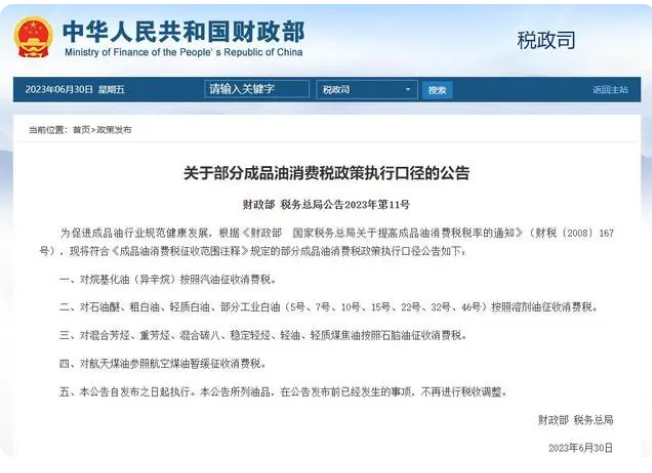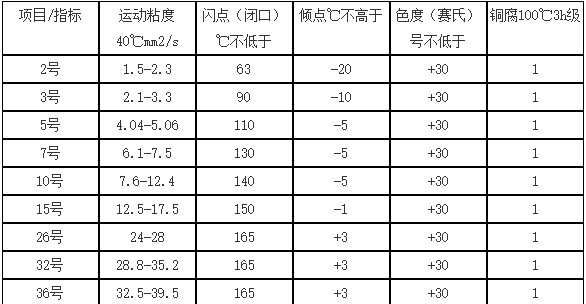In order to promote the standardized and healthy development of the refined oil industry, according to the “Notice of the Ministry of Finance and the State Administration of Taxation on Increasing the Consumption Tax Rate of Refined Oils” (Finance and Taxation [2008] No. 167), the Ministry of Finance and the State Administration of Taxation announced that they are in compliance with the “Refined Oil Products” The implementation standards for certain refined oil consumption tax policies stipulated in the “Explanation on the Scope of Consumption Tax Collection”.

The specific content is: Consumption tax on alkylate oil (isooctane) is levied on gasoline. Consumption tax is levied on petroleum ether, crude white oil, light white oil, and some industrial white oils (No. 5, 7, 10, 15, 22, 32, and 46) as solvent oils. Consumption tax is levied on mixed aromatics, heavy aromatics, mixed carbon eight, stable light hydrocarbons, light oil, and light coal tar as naphtha. The consumption tax on aerospace kerosene will be suspended with reference to aviation kerosene.
The Ministry of Finance stated that the announcement will be implemented from the date of issuance. For the oil products listed in the announcement, no tax adjustments will be made for events that have occurred before the announcement is issued.
Introduction to white oil:
White oil is made from high-grade petroleum fractions. It is made from the boiling fraction (i.e. lubricating oil fraction) after dewaxing, carbonization, neutralization, activated clay decolorization and refining. Colorless and transparent oily liquid with no odor. Relative density: 0.831-0.883, flash point (formula) 164-223℃, kinematic viscosity (40℃) 5.7-46mm2/S, acid value ≤0.05, stable to acid, light and heat, insoluble in ethanol, soluble in ether , benzene, petroleum ether, etc., and can be miscible with most fatty oils. It is a mixture of liquid hydrocarbons, the main component of which is a mixture of C16-C31 normal isoparaffins.
1. According to different classifications of hydrocarbon composition:
(1) Paraffin-based (linear): Paraffin-based white oil is usually used in the daily chemical industry. The white oil produced from paraffin-based mineral oil is usually a high pour point white oil, and the white oil produced from naphthenic mineral oil is usually a low pour point white oil. Comparing the same aromatic content and viscosity in paraffinic and naphthenic oils, the naphthenic oil has a lower aniline point.
(2) Cycloalkyl: Rubber product manufacturers tend to use aromatic hydrocarbon oil (i.e. aromatic base oil) for highly polar rubber types such as NR and SBR, and use paraffin base oil for EPDM, HR and other weakly polar glue types. (Note: The aniline point refers to uniformly mixing equal volumes of aniline and the solvent to be measured with dissolving capacity, gradually lowering the temperature, and observing the lowest temperature at which the system is about to become turbid, which is the aniline point (°C) of the solvent. The aniline of the solvent The higher the point, the weaker its ability to dissolve polar organic compounds.)
2. Classification based on kinematic viscosity measured at 40 degrees Celsius:

(The greater the viscosity of white oil, the worse the fluidity. High and low viscosity meet the needs of various industries for white oil respectively)
3. Classification according to application purposes:
p>
(1) Cosmetic grade: suitable for making cosmetics, and can be used as raw materials for hair cream, hair oil, lipstick, facial oil, skin care oil, sunscreen oil, baby oil, cream and other ointments and softeners.
(2) Industrial grade: It is suitable for chemical fiber, synthetic fiber and other industries. It can be used as a lubricant, solvent and coolant in textiles to make fibers and fabrics soft and bright. It can also be used as a wetting agent, solvent and lubricant in industries such as synthetic resin and plastic processing.
(3) Pharmaceutical grade: suitable for the pharmaceutical industry, and can be used to produce oral agents for the production of laxatives and defoaming agents for the production of penicillin.
(4) Food grade: suitable for food glazing, anti-sticking, decoating, defoaming, sealing, polishing, rust prevention, lubrication and extension of food machinery and surgical instruments, wine vinegar, fruits and vegetables , canned storage period, etc.

 微信扫一扫打赏
微信扫一扫打赏

